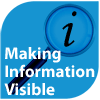 Explore and Understand Data through Visualisation
Explore and Understand Data through Visualisation
Jinfo Blog
27th March 2015
By Andrew Lucas
Abstract
Andrew Lucas gives an overview of how visualisation can help in "Making Information Visible" and in communicating complex data in an easily digestible format. He explains why information managers should ensure that visualisation is part of their toolkit.
Item
 FreePint has been exploring the idea of "visibility" in the Topic Series "Making Information Visible". The series has looked at making information more "discoverable" to users, as well as developing and managing workflow tools that put critical information on the desktops and mobile devices of users at the point of need.
FreePint has been exploring the idea of "visibility" in the Topic Series "Making Information Visible". The series has looked at making information more "discoverable" to users, as well as developing and managing workflow tools that put critical information on the desktops and mobile devices of users at the point of need.
Presentation
One part of the discovery equation is how data is presented. Visualisation is an increasingly important tool for communicating complex data in an easily digestible format. There has been a great proliferation in the use of data visualisation, be it in the media in newspapers and magazines or on websites.
For researchers and other information professionals, visualisation is a core tool for carrying out analysis, allowing them and their users to explore datasets and to identify patterns, associations and trends.
Developing Visualisations
Being able to use visualisation is a useful tool in the information manager’s armoury. You no longer need to be a professional graphic designer to use visualisation to present data or to create infographics, there are dozens of tools that are now available to help you turn data into graphics.
We nearly all use visualisation in some form, often without even thinking about it, through applications such as Excel Charts, which now also includes Bing Maps and People Graph. PowerPoint is perhaps the most widely used tool for creating a visual representation of ideas or information.
How To Do Visualisation Well
When it is done well visualisation can allows users to explore, analyse and understand data as well as enabling them to communicate their finding to others. It can provide a valuable decision support tool.
However, a poorly created visualisation can obscure rather than illuminate the data that being communicated. For example, trying to include too much data can be worse than including too little, whilst a badly designed visualisation will fail to engage with the audience.
Find Out More
In the Subscription Article "What Does It Take to Do Visualisation Well", we look at the principles of what makes good visualisation, which includes thinking about what you are trying to communicate and who your audience is.
We also look at the practical steps that users can take in applying the principles as they go about planning their own use of visualisation, such as where can you source good external data for inclusion in a visualisation and we highlight some of the best visualisation products and services currently available, both free and paid for.
This Blog Item is part of the FreePint Topic Series "Making Information Visible".
- Blog post title: Explore and Understand Data through Visualisation
- Link to this page
- View printable version
- Mini Review of Tableau Desktop
Thursday, 19th March 2015 - Mini Review of NewsEdge Visualisation Features
Friday, 27th February 2015 - Mini Review of Commetric
Friday, 20th February 2015 - Presenting Research Results
Friday, 23rd January 2015 - Using Taxonomies to Harness the Power of Unstructured Big Data and Develop New Insights
Monday, 27th October 2014
- Surfacing Information and Avoiding Visibility Sins
Thursday, 12th March 2015 - Visibility Provides Access to Vital Assets
Monday, 26th January 2015 - Defining "Visibility"
Tuesday, 6th January 2015
Register for our next Community session:

Team demand and AI
22nd January 2026
Latest on our YouTube channel:
Read on the Blog:
December 2025 update
3rd December 2025
- Team roles and AI (Community) 26th February 2026
- Team demand and AI (Community) 22nd January 2026
- Transforming knowledge management at BASF – GenAI and the evolution of QKnows (Community) 10th December 2025